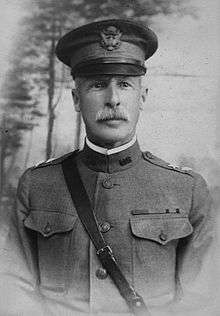Omar Bundy
| Omar Bundy | |
|---|---|
 | |
| Born |
June 17, 1861 New Castle, Indiana, U.S. |
| Died |
January 20, 1940 (aged 78) Washington, D.C., U.S. |
| Buried at | Arlington National Cemetery, Arlington County, Virginia, U.S. |
| Allegiance |
|
| Service/branch |
|
| Years of service | 1883–1925 |
| Rank |
|
| Commands held |
2nd Division Philippine Division VI Corps (United States) |
| Battles/wars |
Indian Wars Spanish–American War Philippine–American War World War I |
| Awards |
Distinguished Service Medal 2nd Division Medal Silver Star Légion d'honneur (France) Croix de Guerre (France) |
Omar Bundy (June 17, 1861 – January 20, 1940) was a U.S. Army general who participated in the Indian Wars and the Spanish–American War in Cuba, fought in the Philippine Insurrection and the Moro Expedition, and commanded a regiment on the Mexican border. After serving in France during World War I, he was made a Commander of the French Legion of Honor.[1]
Early life and education
Bundy was born in 1861 in New Castle, Indiana to Martin and Amanda Bundy.[2]
He graduated from the Military Academy in 1883.[2]
Early Military Career
He served on the American frontier, participating in the Indian Wars campaigns against Crow and Sioux Indians. During the Spanish–American War he fought with the 5th Army Corps in Cuba, and received the Silver Star for gallantry at the Battle of El Caney. From 1899 to 1902, he served in the Philippines during the insurrection and subsequently, after teaching law at Fort Leavenworth, Kansas, participated in the Moro Expedition in the Philippines in 1905–1906. Bundy served within the United States until 1917, where he commanded a regiment on the United States–Mexico border.[3]
During World War I
In 1917, he assumed command of the 1st Brigade, 1st Expeditionary Division, and in June he sailed for France. As a division and corps commander during World War I, he participated in the occupation of the Toulon and Troyon Sectors near Saint-Mihiel, served in the Aisne-Marne operations, and took part in the occupations of Chateau-Thierry.[4] Following the war, he commanded Fort Lee, Virginia, the 7th Corps Area, the Philippine Division, and the 5th Corps Area.[3]
For his services in World War I, General Bundy was awarded the French Legion of Honor, Commander, and the French Croix de Guerre with Palm. However, his bravery in battle has never been officially recognized by the U.S. government.
Later life and death
Bundy retired on June 17, 1925 when he reached the mandatory retirement age of 64.[5]
Upon his retirement, he was awarded the Army Distinguished Service Medal. In January 1934, president Franklin Delano Roosevelt awarded him the 2nd Division Medal.[6] Bundy died in Washington, D.C. on January 20, 1940.[1] He is buried in Section 3 of Arlington National Cemetery alongside his wife, Addie Harden Bundy (b. Knightstown, Indiana, August 31, 1860 – d. Washington, D.C., October 5, 1953).[7]
Legacy
- USS General Omar Bundy (AP-152), launched August 1944, was named in his honor.
References
- 1 2 "Omar Bundy Dies. General In A.E.F. Leader of 2d Division in Battle of Chateau-Thierry, 78. Had Been Ill for Two Years. Won Command Of Corps. Born in Indiana, He Served Also in War With Spain and Philippine Revolt". New York Times. Associated Press.
- 1 2 Davis, Jr., Henry Blaine (1998). Generals in Khaki. Pentland Press, Inc. p. 58. ISBN 1571970886. OCLC 40298151.
- ↑ World War I: The Belfort Ruse HistoryNet.com
- ↑ Davis, Jr., Henry Blaine (1998). Generals in Khaki. Pentland Press, Inc. p. 59. ISBN 1571970886. OCLC 40298151.
- ↑ Seventy-First Annual Report of the Annual Report of the Association of Graduates of the United States Military Academy at West Point, New York. 1940.
- ↑ Omar Bundy Arlington National Cemetery.
External links
| Wikimedia Commons has media related to Omar Bundy. |